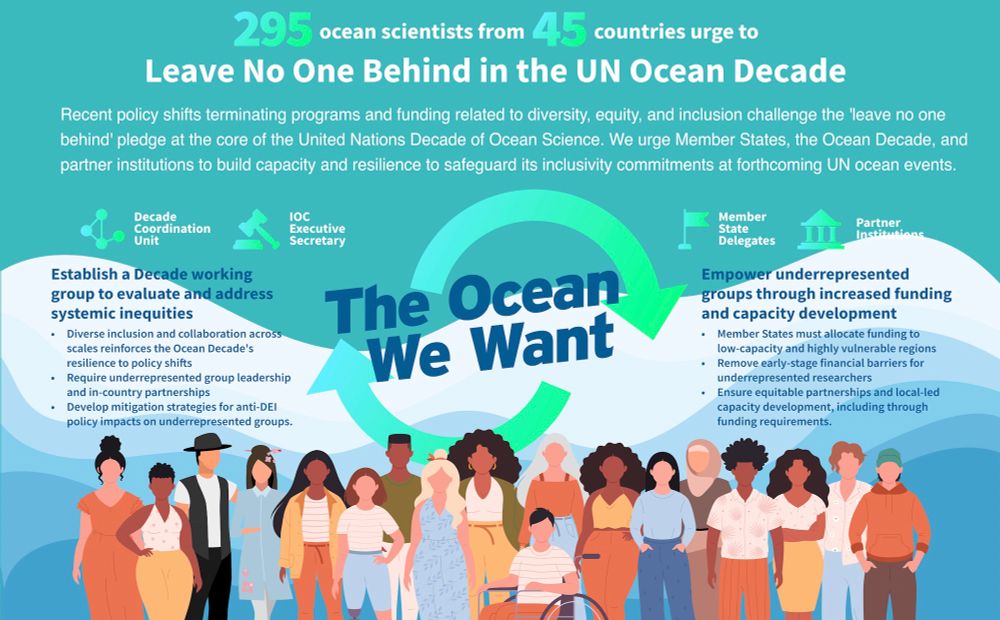
I was one of 295 marine scientists urging to leave no one behind in the UN ocean decade.
The Ocean needs everyone.
Read the paper here: www.sciencedirect.com/science/arti...
🐟🧪
@lisefc.bsky.social
PhD student at the University of Western Australia. Living and Working on Wadandi Country. Studying indigenous wisdom, fish and seabirds 🐠🐦

I was one of 295 marine scientists urging to leave no one behind in the UN ocean decade.
The Ocean needs everyone.
Read the paper here: www.sciencedirect.com/science/arti...
🐟🧪

Antarctic marine ecosystems, despite being remote from industrial pollution, face significant mercury contamination threats to biodiversity. A study investigated mercury levels in the blood of brown and south polar skuas in the South Shetland Islands. tinyurl.com/3tcss2x8
10.06.2025 15:24 — 👍 4 🔁 1 💬 0 📌 0
"Politicians need to listen to the scientists and stop listening to the oligarchs” - Former Chief Scientific Adviser, Sir David King bylinetimes.com/2025/05/19/c... @chrisgpackham.bsky.social @smartyfish.bsky.social @elliechowns.bsky.social @sioldridge.bsky.social @drandrewboswell.bsky.social
19.05.2025 12:45 — 👍 150 🔁 47 💬 3 📌 3
Huge! The Colorado Supreme Court has ruled that Boulder can sue Exxon and Suncor for climate damages, marking a significant step in holding fossil fuel companies accountable for their role in climate change. We need more of this. A lot more.
19.05.2025 10:28 — 👍 44 🔁 13 💬 0 📌 2
"It’s not species being revived, it’s a few of their characteristics being borrowed. It’s like claiming to have brought Napoleon back from the dead by asking a short French man to wear his hat." Rich Grenyer on 'deextinction' in @theconversation.com
theconversation.com/why-de-extin...

Figure 1 in Lameris et al. (2025): "Wintering centroids (median positions) of individual birds per year, general migration routes and study sites in the Arctic. Dots, squares and diamonds show wintering centroids and inverted triangles show study sites, with in (a) sanderlings breeding at Zackenberg (pink) and red-necked phalaropes breeding at Ammarnäs (light blue) and Slettnes (yellow), (b) Arctic skuas (dots) breeding at Kongsfjorden (red) and Slettnes (yellow), long-tailed skuas (squares) breeding at Ammarnäs (light blue) and rough-legged buzzards breeding at Kolguev Island (green dots), and (c) barnacle geese (green diamonds) and greater white-fronted geese (green dots) breeding on Kolguev Island, barnacle geese breeding in Kongsfjorden (red diamonds), pink-footed geese breeding in Adventdalen (dark blue dots) and tundra swans breeding at the Malozemelskaya tundra (orange dots). Broad migration routes are indicated with dotted lines and colours similar to the study sites and wintering centroids. In (c), barnacle geese breeding on Kolguev Island follow the northern green route while greater white-fronted geese use the entire green route. The dotted line indicates the Arctic circle. Photos by Tim Sudlow (tundra swan), Nick Goodrum (pink-footed goose), Jasper Koster (barnacle goose), Nick Athanas (sanderling, greater white-fronted goose), John Quine (Arctic skua), Matti Suopajärvi (rough-legged buzzard) and Alaska Region U.S. Fish & Wildlife Service (red-necked phalarope, long-tailed skua). Map tiles by Stamen Design, under CC BY 4.0. Data by OpenStreetMap, under ODbL"
New publication: Migratory Birds Advance Spring Arrival and Egg-Laying in the Arctic, Mostly by Travelling Faster, by @hanslinssen.bsky.social and others. #climatechange #avianmigration #seabirds #waterfowl #articecosystems
doi.org/10.1111/gcb....
A peculiar male petrel (and Storm-petrel) habit is the courtship growl- I’ve often heard it from burrows but didn’t realise it involved inflation of the throat. Some species can have a very low register for their body size. Here a White-necked Petrel gives it his all. #SuperSeabirdSunday🪶
12.04.2025 20:12 — 👍 49 🔁 6 💬 0 📌 0